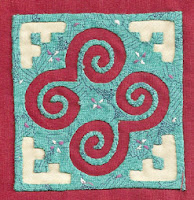The Hmong are an ethnic people, originally from the
mountainous regions of China who were relocated southward by the Chinese
government (along with other tribes) in the 18th C to
become one of the subgroups of Miao ethnicity. In the mid 19th C
they migrated to the mountainous regions of Laos, Thailand and Viet Nam. During the Viet Nam War many of those living
in Laos and Viet Nam aided the American effort and when the US left the area
they were forced to flee to refugee camps in Thailand. Eventually, many emigrated to the US.
The Hmong have brought with them their beautiful needlework
called Pa ndau (pronounced pond-ouw) meaning “flower cloth”. Pa ndau includes crewelwork, cross-stitch, embroidery, needlepoint and
reverse appliqué. The most noteworthy
is reverse appliqué.
Wallace-Homestead Book Co., 1984
A few months ago, I wrote a blog about the San Blas Kuna
Indians of Panama and their tradition of mola-making (also using reverse
appliqué). You cannot mistake one
tradition for the other. Mola makers
use mainly pictorial motifs while Hmong stitchers use geometric designs. To obtain the amazing symmetry of their
geometrics, the Hmong precut the multifolded design before assembling the
layers, while Molas are layered first and then the design is cut. Molas are
rarely symmetrical due to their pictorial nature.
Molas
Pa ndau
The stitches in Pa ndau appliqué are nearly invisible. After the reverse appliqué is complete,
embellishment may be added by extremely fine embroidery or the addition of
further reverse appliqué or simple surface appliqué.
 |

 |
Three Ring Snailhouse Motif
 |
Heart
Motif
Elephant's Foot Motif
 |
 |
Leaf'Petal Motif |
Bar Morif with Rickrack corners
 |
Rams Head Motif |
 |
| Rams Head Motif with Simple Cross |
 |
| Rams Head Motif with Simple Cross |
Hearts and Rings Motif
 |
| Petitpoint needlepoint Pa ndau |








No comments:
Post a Comment